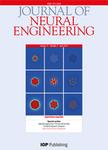版权所有:内蒙古大学图书馆 技术提供:维普资讯• 智图
内蒙古自治区呼和浩特市赛罕区大学西街235号 邮编: 010021

作者机构:Chinese Acad Sci Inst Semicond Key Lab Solid State Optoelect Informat Technol Beijing Peoples R China Univ Chinese Acad Sci Coll Mat Sci & Optoelect Technol Beijing Peoples R China Univ Chinese Acad Sci Sch Future Technol Beijing Peoples R China Tsinghua Univ Dept Biomed Engn Beijing Peoples R China Chinese Inst Brain Res Beijing Peoples R China
出 版 物:《JOURNAL OF NEURAL ENGINEERING》 (J. Neural Eng.)
年 卷 期:2025年第22卷第1期
页 面:016011-016011页
核心收录:
学科分类:0831[工学-生物医学工程(可授工学、理学、医学学位)] 1002[医学-临床医学] 1001[医学-基础医学(可授医学、理学学位)] 10[医学]
基 金:National Key Research and Development Program of Chinahttp://dx.doi.org/10.13039/501100012166 National Natural Science Foundation of China [2022YFF1202303] National Key Research and Development Program of China
主 题:Brain-computer interface (BCI) steady-state visual evoked potential (SSVEP) grid stimulus stimulation area proportion user experience
摘 要:Objective. Steady-state visual evoked potentials (SSVEPs) rely on the photic driving response to encode electroencephalogram (EEG) signals stably and efficiently. However, the user experience of the traditional stimulation with high-contrast flickers urgently needs to be improved. In this study, we introduce a novel paradigm of grid stimulation with weak flickering perception, distinguished by a markedly lower proportion of stimulation area in the overall pattern. Approach. In an offline single-target experiment, we investigated the unique characteristics of SSVEPs evoked by varying proportions in grid stimuli within low and medium frequency bands. Based on the analysis of simulation performance across a four-class brain-computer interface (BCI) task and the evaluation of user experience questionnaires, a subset of paradigms that balance performance and comfort were selected for implementation in four-target online BCI systems. Main results. Our results demonstrate that even ultra-low stimulation proportion paradigms can still evoke strong responses within specific frequency bands, effectively enhancing user experience with low and middle frequency stimuli. Notably, proportions of 0.94% and 2.10% within the 3-5 Hz range provide an optimal balance between performance and user experience. For frequencies extending up to 15 Hz, a 2.10% proportion remains ideal. At 20 Hz, slightly higher proportions of 3.75% and 8.43% maintain these benefits. Significance. These findings are crucial for advancing the development of effective and user-friendly SSVEP-based BCI systems.